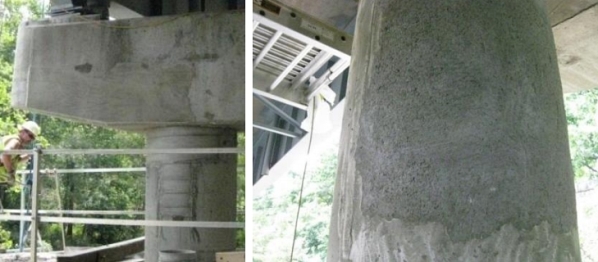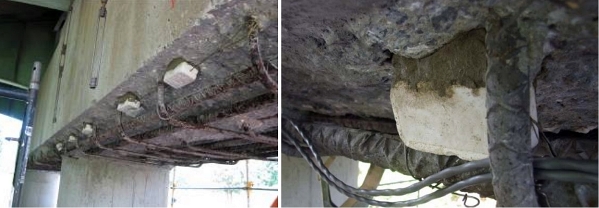In bridge substructure elements containing vertical and overhead sections, issues such as leaking joints, shy cover depth, poor quality concrete, and lack of consolidation have commonly contributed to corrosion-related spalling over the years, according to study co-authors H. Celik Ozyildirim and Stephen R. Sharp. In turn, this has often led to costly repairs.
However, the researchers believe this relatively new self-consolidating concrete technology could offer a solution.
According to the research team, self-consolidating concrete is a relatively new technology that offers high flow rates, bonds well, has low permeability, and provides smooth surfaces in comparison to traditional methods such as using shotcrete. The self-consolidating concrete can also be placed in narrow areas and fit the existing geometry of a structure.
The technology has been used in Japan and Europe since the early 1990s, they say, and VDOT has since used it successfully in beams, drilled shafts, and pier caps.
“Self-consolidating concrete easily fills the congested spaces between the reinforcement and the formwork under the influence of its own mass and without the addition of consolidation energy, such as vibration,” the researchers write. “It also improves the quality of concrete by enhancing strength and reducing permeability, prolonging the repair life by minimizing the intrusion of chlorides that initiate corrosion.”
Other advantages of the technology, according to the team, include smooth surfaces, which eliminate the need for additional labor to finish the surface of concrete elements; a faster rate of concrete placement, since there is no need for consolidation; good bonding; improved safety with limited or no vibration, thus eliminating the need for patches; and greater consistency in the quality of repair concrete.

Historical Alternatives
Historically, repairs of bridge substructure elements in Virginia have utilized either shotcrete or a conventional VDOT Class A3 (3,000 psi) or Class A4 (4,000 psi) concrete. However, both repair systems offer significant drawbacks.
For the conventional concrete, formwork is built that usually contains a larger volume than the area to be repaired. This is done to enable the placement and consolidation of concrete with consistency.
“Therefore, the resulting repaired area often protrudes, does not match the geometry of the existing element, and is not aesthetically pleasing,” the researchers say. “In addition, the consolidation and quality of these repairs are of concern.” In comparison to conventional concrete, shotcrete has an advantage of not requiring formwork. However, qualifications of the operator, cost, and quality of the end product have provided separate issues of concern.
“Shotcrete is projected under velocity to the surface, requiring special equipment and an experienced operator to ensure proper placement, thus making it a specialized and costly repair system,” the researchers say. “Moreover, in small jobs, mobilizing the shotcrete equipment and finding a qualified operator can be an issue, and the field experience of shotcrete repairs indicates variable performance.”
In both repair systems, bonding of the repair material to the existing concrete has also been reported as an occasional problem, according to the researchers.
Bridge Case Studies
Because of those limitations, VDOT began using the self-consolidating concrete on a number of bridges in the state earlier this decade.
Placement of the self-consolidating concrete into formwork was facilitated by applying pressure through pumping or by pouring from height. In contrast, pouring from small buckets without height would not provide the required flow through congested areas and narrow openings, the researchers explain.

While some minor installation issues are encountered, the researchers say workarounds were available. For instance, they were able to prevent form bulging by securing the forms firmly and restricting the height of the placement. Though the self-consolidating concrete did occasionally lose workability during placement, slump flow checks during the placement process were used to indicate if the concrete still had the desired workability. If it did not, mechanical vibration was applied.
“With the use of workability retaining admixtures or retarding admixtures, workability of the self-consolidating concrete can be maintained during placement,” the researchers write.
After years of testing, the VDOT study found that repairs made with self-consolidating concrete were completed successfully, with the repaired areas not exhibiting corrosion.
The self-consolidating concrete did have high variability in air content, slump flow, strength, and permeability, indicating some sensitivity to water. However, satisfactory values exceeding the minimum levels specified for corrosion protection were recorded. “Based on the field results, repairs of substructure elements should be performed using [self-consolidating concrete] mixtures when possible,” the researchers conclude. “These repairs can be aesthetically pleasing if the formwork is carefully installed, as the finished surface will strongly replicate the form surfaces and edges when the forms are removed.”
“In addition, the use of [self-consolidating concrete] mixtures ensures that the repair concrete is of known quality and will flow through restrictive areas and fill the entire repair volume when the repair is properly performed. Although small vertical cracks were evident in the patched areas, they did not appear to reduce durability. This was based on the observation that after seven years of service, the repairs and areas around the repairs did not exhibit corrosion activity.”
Galvanic Anodes in Patch Areas
Their study also explored a related issue involving the use of galvanic anodes in self-consolidating concrete repairs.
“In these systems, corrosion of the reinforcement in or adjacent to the repair has been a concern,” the researchers say. Since the original concrete can often have a different chloride content and pH than the repair material, these differences can lead to ring corrosion, where the reinforcement adjacent to the repaired area corrodes. In turn, the concrete then cracks and spalls.

To address this, VDOT has been evaluating the use of galvanic anodes. The zinc in the anodes corrodes in place of steel, thus protecting the steel from damage. Also, because the galvanic anode system is self-contained, it does not require an outside power source. These anodes do have a limited life span, however, since they lose effectiveness once the zinc has passivated or becomes depleted.
In the study, the self-consolidating concrete with embedded galvanic anodes was applied to some bridges and without anodes to other bridges. This allowed the researchers to compare and contrast.
In patch areas with anodes, they found the anodes did provide protection to the steel immediately adjacent to the repair area. But steel in chloride-contaminated concrete located away from the repairs was not protected, and corrosion was found to be progressing.
In these corroded areas, the researchers say the concrete was initially considered acceptable based on sounding conducted during repairs. However, they warn that concrete sounding is not a reliable method to locate chloride-contaminated concrete, since it requires the concrete to be delaminated. Instead, they say a more reliable method involves taking half-cell potential measurements.
In the case of their study, they say the proliferation of corrosion shows it is necessary to remove all chloride-contaminated concrete adjacent to the reinforcement, as anodes in the patch will only provide protection in a narrow area around the patch.
“Seven years of experience has shown that anodes do provide protection to the steel in a limited area adjacent to the repair,” the researchers write. “But areas outside this limited region are not protected; corrosion is progressing in these unprotected areas and requires repair.”
Implementation of the Findings
Based on their research, VDOT has updated its road and bridge specifications to include the use of self-consolidating concrete as a preferred option for substructure surface repairs. In addition, VDOT’s structure and bridge division has agreed to provide guidance for the use of self-consolidating concrete for repairs in a special provision or best practice guide to be developed by the end of 2018.
Separately, the Virginia Transportation Research Council (VRTC) (Charlottesville, Virginia) has pledged to continue monitoring the corrosion activity in the substructure elements that were repaired—both with and without anodes—to determine how long the repairs last and how long corrosion is delayed.
On those substructures, VTRC plans to conduct visual observation and measurement of the current and voltage readings at two-year intervals until repairs fail.
All of the work is sponsored by VDOT and the U.S. Federal Highway Administration.
Source: VDOT, www.virginiadot.org. Contact Stephen R. Sharp, VDOT—email: Stephen.Sharp@VDOT.Virginia.gov.
Reference
1 “Repairs with Self-Consolidating Concrete and Galvanic Anodes to Extend Bridge Life,” Virginia Transportation Research Council, August 2017, http://www.virginiadot.org/vtrc/main/online_reports/pdf/18-r9.pdf (Sept. 11, 2017).